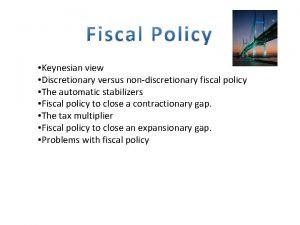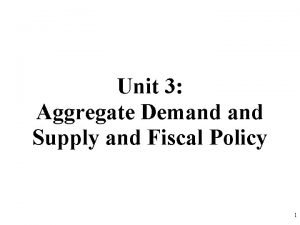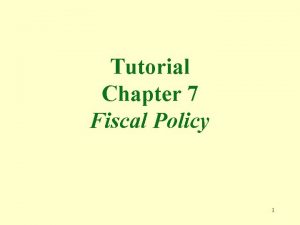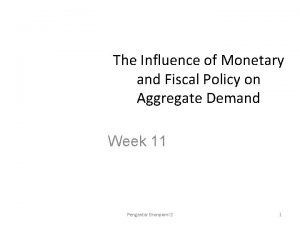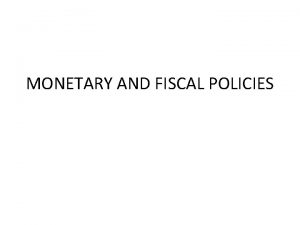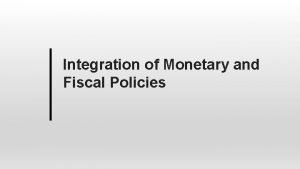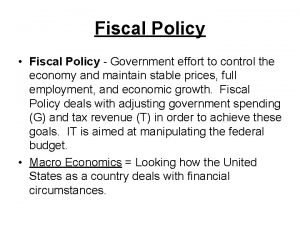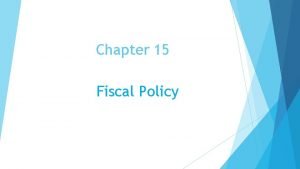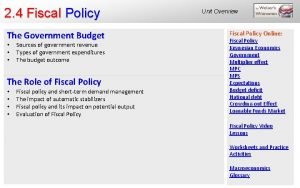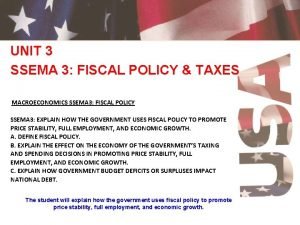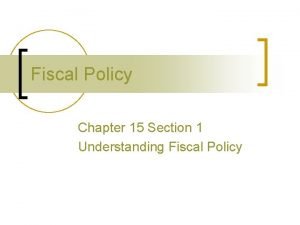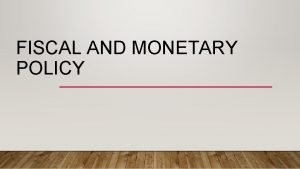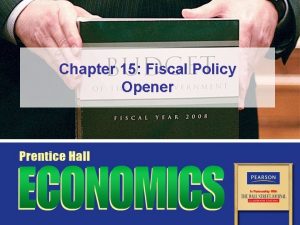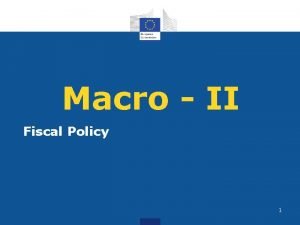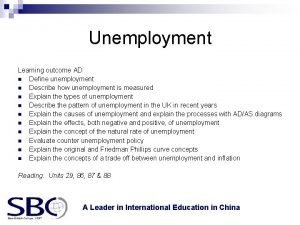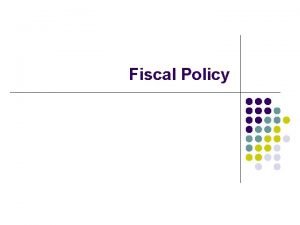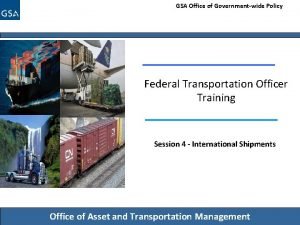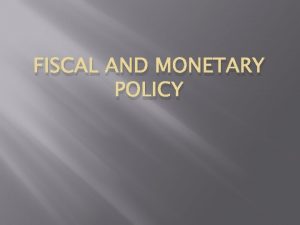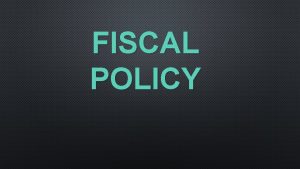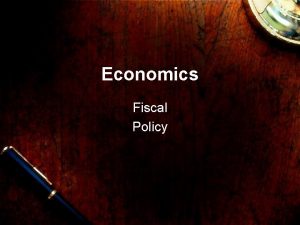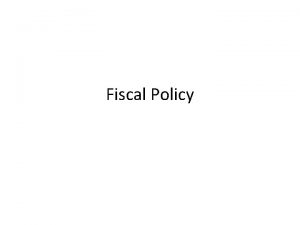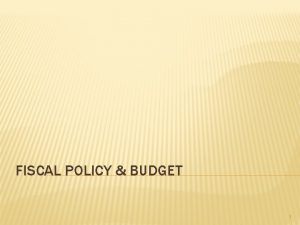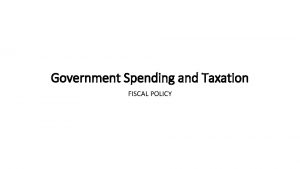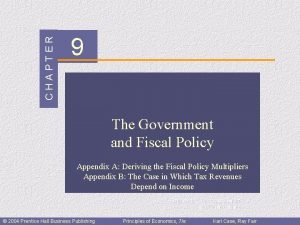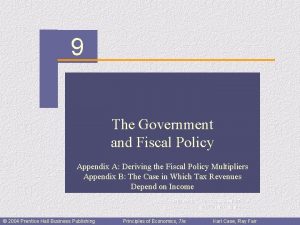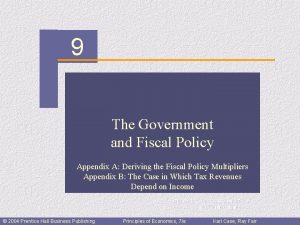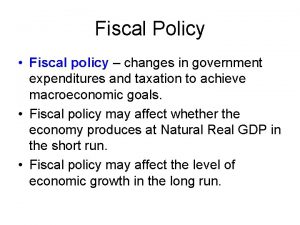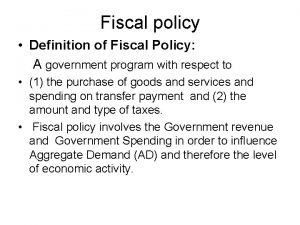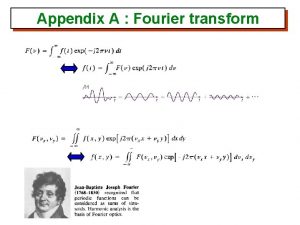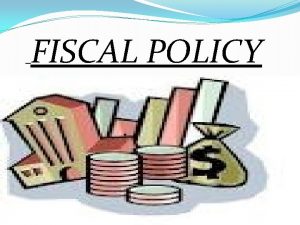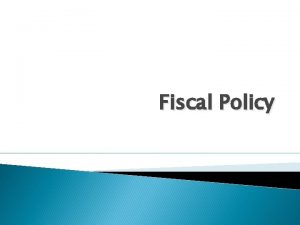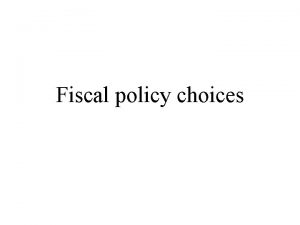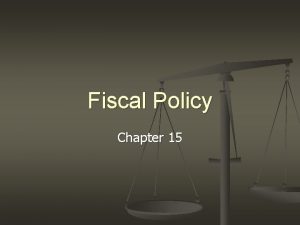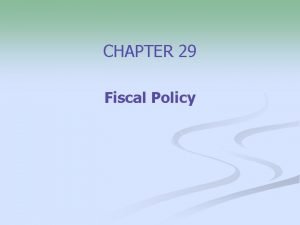CHAPTER 21 The Government and Fiscal Policy Appendix



































- Slides: 35

CHAPTER 21 The Government and Fiscal Policy Appendix A: Deriving the Fiscal Policy Multipliers Appendix B: The Case in Which Tax Revenues Depend on Income Prepared by: Fernando Quijano and Yvonn Quijano © 2004 Prentice Hall Business Publishing Principles of Economics, 7/e Karl Case, Ray Fair

C H A P T E R 21: The Government and Fiscal Policy Government in the Economy • Nothing arouses as much controversy as the role of government in the economy. • Government can affect the macroeconomy in two ways: • Fiscal policy is the manipulation of government spending and taxation. • Monetary policy refers to the behavior of the Federal Reserve regarding the nation’s money supply. © 2004 Prentice Hall Business Publishing Principles of Economics, 7/e Karl Case, Ray Fair 2

C H A P T E R 21: The Government and Fiscal Policy Government in the Economy • Discretionary fiscal policy refers to deliberate changes in taxes or spending. • The government can not control certain aspects of the economy related to fiscal policy. For example: • The government can control tax rates but not tax revenue. Tax revenue depends on household income and the size of corporate profits. • Government spending depends on government decisions and the state of the economy. © 2004 Prentice Hall Business Publishing Principles of Economics, 7/e Karl Case, Ray Fair 3

C H A P T E R 21: The Government and Fiscal Policy Net Taxes (T), and Disposable Income (Yd) • Net taxes are taxes paid by firms and households to the government minus transfer payments made to households by the government. • Disposable, or after-tax, income (Yd ) equals total income minus taxes. © 2004 Prentice Hall Business Publishing Principles of Economics, 7/e Karl Case, Ray Fair 4

C H A P T E R 21: The Government and Fiscal Policy Adding Net Taxes (T) and Government Purchases (G) to the Circular Flow of Income © 2004 Prentice Hall Business Publishing Principles of Economics, 7/e Karl Case, Ray Fair 5

C H A P T E R 21: The Government and Fiscal Policy Adding Net Taxes (T) and Government Purchases (G) to the Circular Flow of Income • When government enters the picture, the aggregate income identity gets cut into three pieces: • And aggregate expenditure (AE) equals: © 2004 Prentice Hall Business Publishing Principles of Economics, 7/e Karl Case, Ray Fair 6

C H A P T E R 21: The Government and Fiscal Policy The Budget Deficit • A government’s budget deficit is the difference between what it spends (G) and what it collects in taxes (T) in a given period: • If G exceeds T, the government must borrow from the public to finance the deficit. It does so by selling Treasury bonds and bills. In this case, a part of household saving (S) goes to the government. © 2004 Prentice Hall Business Publishing Principles of Economics, 7/e Karl Case, Ray Fair 7

C H A P T E R 21: The Government and Fiscal Policy Adding Taxes to the Consumption Function • The aggregate consumption function is now a function of disposable, or after-tax, income. © 2004 Prentice Hall Business Publishing Principles of Economics, 7/e Karl Case, Ray Fair 8

C H A P T E R 21: The Government and Fiscal Policy Equilibrium Output: Y = C + I + G Finding Equilibrium for I = 100, G = 100, and T = 100 (All Figures in Billions of Dollars) (1) (2) (3) DISPOSABLE OUTPUT NET INCOME (INCOME) TAXES Yd / Y - T Y T (4) CONSUMPTION SPENDING (C = 100 +. 75 Yd) (5) (6) (7) (8) (9) (10) PLANNED UNPLANNED SAVING INVESTMENT GOVERNMENT AGGREGATE INVENTORY ADJUSTMENT S SPENDING PURCHASES EXPENDITURE CHANGE TO (Yd – C) I G C+I+G Y - (C + I + G) DISEQUILIBRIUM 300 100 250 - 50 100 450 - 150 Output 8 500 100 400 0 100 600 - 100 Output 8 700 100 600 550 50 100 750 - 50 Output 8 900 100 800 700 100 100 900 0 1, 100 1, 000 850 100 1, 050 + 50 Output 9 1, 300 1, 200 1, 000 200 100 1, 200 + 100 Output 9 1, 500 1, 400 1, 150 250 100 1, 350 + 150 Output 9 © 2004 Prentice Hall Business Publishing Principles of Economics, 7/e Karl Case, Ray Fair Equilibrium 9

C H A P T E R 21: The Government and Fiscal Policy Finding Equilibrium Output/Income Graphically © 2004 Prentice Hall Business Publishing Principles of Economics, 7/e Karl Case, Ray Fair 10

C H A P T E R 21: The Government and Fiscal Policy The Leakages/Injections Approach • Taxes (T) are a leakage from the flow of income. Saving (S) is also a leakage. • In equilibrium, aggregate output (income) (Y) equals planned aggregate expenditure (AE), and leakages (S + T) must equal planned injections (I + G). Algebraically, © 2004 Prentice Hall Business Publishing Principles of Economics, 7/e Karl Case, Ray Fair 11

C H A P T E R 21: The Government and Fiscal Policy The Government Spending Multiplier • The government spending multiplier is the ratio of the change in the equilibrium level of output to a change in government spending. © 2004 Prentice Hall Business Publishing Principles of Economics, 7/e Karl Case, Ray Fair 12

C H A P T E R 21: The Government and Fiscal Policy The Government Spending Multiplier Finding Equilibrium After a $50 Billion Government Spending Increase (All Figures in Billions of Dollars; G Has Increased From 100 in Table 25. 1 to 150 Here) (1) (2) (3) (4) OUTPUT NET DISPOSABLE CONSUMPTION INCOME (INCOME) TAXES SPENDING Yd / Y - T (C = 100 +. 75 Yd) Y T (5) (6) (7) (8) (9) (10) PLANNED UNPLANNED SAVING INVESTMENT GOVERNMENT AGGREGATE INVENTORY ADJUSTMENT S SPENDING PURCHASES EXPENDITURE CHANGE TO (Yd – C) I G C+I+G Y - (C + I + G) DISEQUILIBRIUM 300 100 250 - 50 100 150 500 - 200 Output 8 500 100 400 0 100 150 650 - 150 Output 8 700 100 600 550 50 100 150 800 - 100 Output 8 900 100 800 700 100 150 950 - 50 Output 8 1, 100 1, 000 850 100 150 1, 100 0 1, 300 1, 200 1, 000 200 150 1, 250 + 50 © 2004 Prentice Hall Business Publishing Principles of Economics, 7/e Karl Case, Ray Fair Equilibrium Output 9 13

C H A P T E R 21: The Government and Fiscal Policy The Government Spending Multiplier © 2004 Prentice Hall Business Publishing Principles of Economics, 7/e Karl Case, Ray Fair 14

C H A P T E R 21: The Government and Fiscal Policy The Tax Multiplier • A tax cut increases disposable income, and leads to added consumption spending. Income will increase by a multiple of the decrease in taxes. • A tax cut has no direct impact on spending. The multiplier for a change in taxes is smaller than the multiplier for a change in government spending. © 2004 Prentice Hall Business Publishing Principles of Economics, 7/e Karl Case, Ray Fair 15

C H A P T E R 21: The Government and Fiscal Policy The Tax Multiplier © 2004 Prentice Hall Business Publishing Principles of Economics, 7/e Karl Case, Ray Fair 16

C H A P T E R 21: The Government and Fiscal Policy The Balanced-Budget Multiplier • The balanced-budget multiplier is the ratio of change in the equilibrium level of output to a change in government spending where the change in government spending is balanced by a change in taxes so as not to create any deficit. © 2004 Prentice Hall Business Publishing Principles of Economics, 7/e Karl Case, Ray Fair 17

C H A P T E R 21: The Government and Fiscal Policy The Balanced-Budget Multiplier Finding Equilibrium After a $200 Billion Balanced Budget Increase in G and T (All Figures in Billions of Dollars; G and T Have Increased From 100 in Table 25. 1 to 300 Here) (1) OUTPUT (INCOME) Y (2) (3) NET DISPOSABLE TAXES INCOME Yd / Y - T T (4) (5) (6) (7) PLANNED CONSUMPTION INVESTMENT GOVERNMENT AGGREGATE SPENDING PURCHASES EXPENDITURE (C = 100 +. 75 Yd) I G C+I+G (8) (9) UNPLANNED INVENTORY CHANGE Y - (C + I + G) ADJUSTMENT TO DISEQUILIBRIUM 500 300 250 100 300 650 - 150 Output 8 700 300 400 100 300 800 - 100 Output 8 900 300 600 550 100 300 950 - 50 Output 8 1, 100 300 800 700 100 300 1, 100 0 1, 300 1, 000 850 100 300 1, 250 + 50 Output 9 1, 500 300 1, 200 1, 000 100 300 1, 400 + 100 Output 9 © 2004 Prentice Hall Business Publishing Principles of Economics, 7/e Karl Case, Ray Fair Equilibrium 18

C H A P T E R 21: The Government and Fiscal Policy Multipliers Summary of Fiscal Policy Multipliers POLICY STIMULUS Governmentspending multiplier Increase or decrease in the level of government purchases: Tax multiplier Increase or decrease in the level of net taxes: Balancedbudget multiplier Simultaneous balanced-budget increase or decrease in the level of government purchases and net taxes: © 2004 Prentice Hall Business Publishing MULTIPLIER Principles of Economics, 7/e FINAL IMPACT ON EQUILIBRIUM Y 1 Karl Case, Ray Fair 19

C H A P T E R 21: The Government and Fiscal Policy The Federal Budget • The federal budget is the budget of the federal government. • The difference between the federal government’s receipts and its expenditures is the federal surplus (+) or deficit (-). © 2004 Prentice Hall Business Publishing Principles of Economics, 7/e Karl Case, Ray Fair 20

C H A P T E R 21: The Government and Fiscal Policy The Federal Budget Federal Government Receipts and Expenditures, 2000 (Billions of Dollars) AMOUNT PERCENTAGE OF TOTAL Receipts Personal taxes Corporate taxes Indirect business taxes Contributions for social insurance Total 1, 010. 1 193. 2 111. 0 720. 6 2, 034. 9 49. 6 9. 5 5. 5 35. 4 100. 0 Current Expenditures Consumption Transfer payments Grants-in-aid to state and local governments Net interest payments Net subsidies of government enterprises Total Current Surplus (+) or deficit (-) (Receipts - Current Expenditures) 514. 1 831. 9 274. 2 236. 9 52. 5 1, 909. 6 + 125. 3 26. 9 43. 6 14. 4 12. 4 2. 7 100. 0 Source: U. S. Department of Commerce, Bureau of Economic Analysis. © 2004 Prentice Hall Business Publishing Principles of Economics, 7/e Karl Case, Ray Fair 21

C H A P T E R 21: The Government and Fiscal Policy The Federal Government Surplus (+) or Deficit (-) as a Percentage of GDP, 1970 I-2003 II © 2004 Prentice Hall Business Publishing Principles of Economics, 7/e Karl Case, Ray Fair 22

C H A P T E R 21: The Government and Fiscal Policy The Debt • The federal debt is the total amount owed by the federal government. The debt is the sum of all accumulated deficits minus surpluses over time. • Some of the federal debt is held by the U. S. government itself and some by private individuals. The privately held federal debt is the private (nongovernment-owned) portion of the federal debt. © 2004 Prentice Hall Business Publishing Principles of Economics, 7/e Karl Case, Ray Fair 23

C H A P T E R 21: The Government and Fiscal Policy The Federal Government Debt as a Percentage of GDP, 1970 I-2003 II The percentage began to fall in the mid 1990 s. © 2004 Prentice Hall Business Publishing Principles of Economics, 7/e Karl Case, Ray Fair 24

C H A P T E R 21: The Government and Fiscal Policy The Economy’s Influence on the Government Budget • Automatic stabilizers are revenue and expenditure items in the federal budget that automatically change with the state of the economy in such a way as to stabilize GDP. © 2004 Prentice Hall Business Publishing Principles of Economics, 7/e Karl Case, Ray Fair 25

C H A P T E R 21: The Government and Fiscal Policy The Economy’s Influence on the Government Budget • Fiscal drag is the negative effect on the economy that occurs when average tax rates increase because taxpayers have moved into higher income brackets during an expansion. © 2004 Prentice Hall Business Publishing Principles of Economics, 7/e Karl Case, Ray Fair 26

C H A P T E R 21: The Government and Fiscal Policy The Economy’s Influence on the Government Budget • The full-employment budget is what the federal budget would be if the economy were producing at a full-employment level of output. © 2004 Prentice Hall Business Publishing Principles of Economics, 7/e Karl Case, Ray Fair 27

C H A P T E R 21: The Government and Fiscal Policy The Economy’s Influence on the Government Budget • The cyclical deficit is the deficit that occurs because of a downturn in the business cycle. • The structural deficit is the deficit that remains at full employment. © 2004 Prentice Hall Business Publishing Principles of Economics, 7/e Karl Case, Ray Fair 28

C H A P T E R 21: The Government and Fiscal Policy Review Terms and Concepts automatic stabilizers fiscal drag balanced-budget multiplier fiscal policy budget deficit full-employment budget cyclical deficit government spending multiplier discretionary fiscal policy monetary policy disposable, or after-tax, income net taxes privately held federal debt federal budget structural deficit federal debt tax multiplier federal surplus (+) or deficit (-) © 2004 Prentice Hall Business Publishing Principles of Economics, 7/e Karl Case, Ray Fair 29

C H A P T E R 21: The Government and Fiscal Policy Appendix A: Deriving the Fiscal Policy Multipliers The government spending and tax multipliers algebraically: © 2004 Prentice Hall Business Publishing Principles of Economics, 7/e Karl Case, Ray Fair 30

C H A P T E R 21: The Government and Fiscal Policy Appendix A: Deriving the Fiscal Policy Multipliers • The balanced-budget multiplier is found by combining the effects of government spending and taxes: increase in spending: - decrease in spending: = net increase in spending © 2004 Prentice Hall Business Publishing • The balanced-budget multiplier equals one. An increase in G and T by one dollar each causes a one-dollar increase in Y. Principles of Economics, 7/e Karl Case, Ray Fair 31

C H A P T E R 21: The Government and Fiscal Policy Appendix B: The Case In Which Tax Revenues Depend on Income © 2004 Prentice Hall Business Publishing Principles of Economics, 7/e Karl Case, Ray Fair 32

C H A P T E R 21: The Government and Fiscal Policy Appendix B: The Case In Which Tax Revenues Depend on Income © 2004 Prentice Hall Business Publishing Principles of Economics, 7/e Karl Case, Ray Fair 33

C H A P T E R 21: The Government and Fiscal Policy Appendix B: The Case In Which Tax Revenues Depend on Income The Government Spending and Tax Multipliers Algebraically: © 2004 Prentice Hall Business Publishing Principles of Economics, 7/e Karl Case, Ray Fair 34

C H A P T E R 21: The Government and Fiscal Policy Appendix B: The Case In Which Tax Revenues Depend on Income • The government spending and tax multipliers when taxes are a function of income are derived as follows: © 2004 Prentice Hall Business Publishing Principles of Economics, 7/e Karl Case, Ray Fair 35
 Contractionary monetary policies
Contractionary monetary policies Unit 3 aggregate demand aggregate supply and fiscal policy
Unit 3 aggregate demand aggregate supply and fiscal policy Unit 3 aggregate demand aggregate supply and fiscal policy
Unit 3 aggregate demand aggregate supply and fiscal policy Define non-discretionary fiscal policy
Define non-discretionary fiscal policy Unit 3 aggregate demand aggregate supply and fiscal policy
Unit 3 aggregate demand aggregate supply and fiscal policy Inflation
Inflation Example fiscal policy
Example fiscal policy Government expenditure multiplier formula
Government expenditure multiplier formula Components of fiscal policy
Components of fiscal policy Crowding out effect of fiscal policy
Crowding out effect of fiscal policy What is liquidity ratio in banking
What is liquidity ratio in banking Fiscal policy
Fiscal policy Econ crowding out
Econ crowding out Fiscal demand side policy
Fiscal demand side policy Fiscal policy to control inflation
Fiscal policy to control inflation Types of fiscal policy
Types of fiscal policy Instruments of fiscal policy
Instruments of fiscal policy Crowding out
Crowding out Demand side fiscal policy definition
Demand side fiscal policy definition Contractionary monetary policies
Contractionary monetary policies Crowding out effect of fiscal policy
Crowding out effect of fiscal policy Example of expansionary fiscal policy
Example of expansionary fiscal policy Iousa worksheet
Iousa worksheet Goals of fiscal policy
Goals of fiscal policy Fiscal vs monetary policy
Fiscal vs monetary policy Goals of fiscal policy
Goals of fiscal policy Fiscal policy
Fiscal policy Unemployment graph macroeconomics
Unemployment graph macroeconomics Fiscal policy in macroeconomics
Fiscal policy in macroeconomics Features of fiscal policy ppt
Features of fiscal policy ppt Fiscal policy definition
Fiscal policy definition What is fiscal deficit
What is fiscal deficit Gsa office of governmentwide policy
Gsa office of governmentwide policy Senior policy officer scottish government
Senior policy officer scottish government National government vs federal government
National government vs federal government Hát kết hợp bộ gõ cơ thể
Hát kết hợp bộ gõ cơ thể



